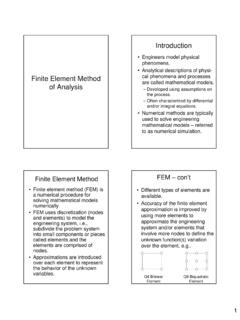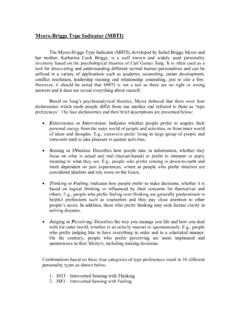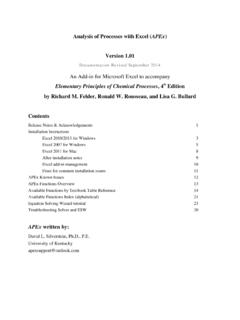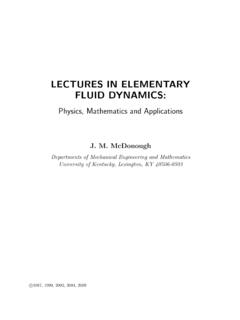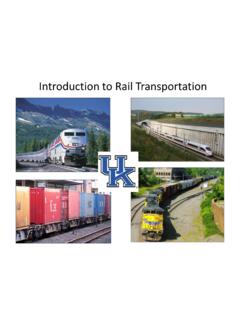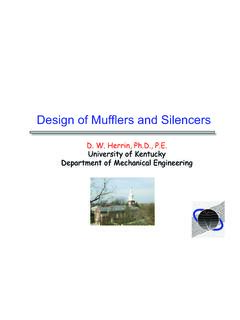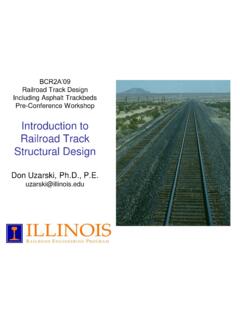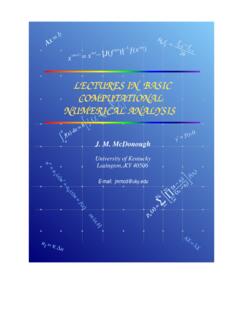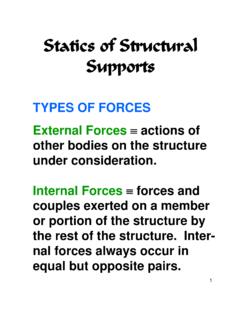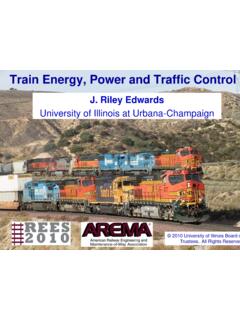Transcription of 07 Sound Absorbing Materials - University of Kentucky
1 D. W. Herrin, , University of Kentucky Department of Mechanical Engineering Sound Absorbing Materials Sound Absorption by Porous Materials Noise and Vibration Short Course 2 Dept. of Mech. Engineering University of Kentucky Overview D The Basics D Impedance and Absorption D Transfer Matrix Approach D Flow Resistivity Sound Absorption by Porous Materials Noise and Vibration Short Course 3 Dept. of Mech. Engineering University of Kentucky Relatively massive, stiff barrier having high damping Most Sound is reflected Some Sound is transmitted Less Sound is reflected Less Sound is transmitted ( These two objectives can be combined) Sound Blocking Versus Sound Absorption Sound Absorption by Porous Materials Noise and Vibration Short Course 4 Dept.
2 Of Mech. Engineering University of Kentucky Bedroom Noisy family or playroom Ways to reduce noise level in the bedroom: Which use Sound blocking and which use Sound absorption? Example Sound Absorption by Porous Materials Noise and Vibration Short Course 5 Dept. of Mech. Engineering University of Kentucky Sound Absorbing Materials Sound Absorption by Porous Materials Noise and Vibration Short Course 6 Dept. of Mech. Engineering University of Kentucky NVH Applications Driven by Auto Industry Sound Absorption by Porous Materials Noise and Vibration Short Course 7 Dept. of Mech. Engineering University of Kentucky Sound Absorbing Materials in Car Sound Absorption by Porous Materials Noise and Vibration Short Course 8 Dept.
3 Of Mech. Engineering University of Kentucky a: fully reticulated plastic foam (x14) b: partially reticulated plastic foam (x14) c: glass fiber (x14) d: mineral (rock) wool (x14) Examples of Sound Absorbing Materials Sound Absorption by Porous Materials Noise and Vibration Short Course 9 Dept. of Mech. Engineering University of Kentucky D Foams are made of various Materials including polyurethane, polyethylene , and polypropylene. D Foams are created by pouring premixed liquid products onto a conveyor and allowing the chemical process to create cells (voids) of various size as the foam cures and hardens. Similar to bread rising.
4 D If the cell walls are fractured, the foam is called open cell D If the cell walls remain intact, the foam is called closed cell D Coverings such vinyl, aluminum, urethane, or aluminized mylar protect the surface, improve appearance, and reduce absorption of liquids, dirt, etc. D Coverings may also act as a barrier, , loaded vinyl Foam Manufacture and Foam Types Sound Absorption by Porous Materials Noise and Vibration Short Course 10 Dept. of Mech. Engineering University of Kentucky D Suspended baffles in gymnasiums or factories D Under hood applications for engine noise D Vehicle interiors D Inside building walls improves transmission loss D Inside office and computer equipment reduces reverberant buildup of Sound D Ceiling tiles and carpeting D HVAC applications duct liner Applications of Sound Absorbing Materials Sound Absorption by Porous Materials Noise and Vibration Short Course 11 Dept.
5 Of Mech. Engineering University of Kentucky Sound is absorbed by converting Sound energy to heat within the material, resulting in a reduction of the Sound pressure. Two primary mechanisms: D vibration of the material skeleton - damping D friction of the fluid on the skeleton - viscosity Mechanisms of Sound Absorption Sound Absorption by Porous Materials Noise and Vibration Short Course 12 Dept. of Mech. Engineering University of Kentucky Vibration of the material matrix is caused by Sound pressure and velocity fluctuations within the material. Damping of the material converts Sound to heat. Important for light Materials at low frequencies.
6 Difficult to model and measure (ignored here) Vibration of Material Skeleton Sound Absorption by Porous Materials Noise and Vibration Short Course 13 Dept. of Mech. Engineering University of Kentucky The oscillating fluid particles within the material rub against the matrix and create heat by friction (viscosity). Primary material parameters affecting absorption: D porosity (fraction of air volume in the material) D structure factor (orientation of fibers, tortuosity) D flow resistance Friction of the Fluid on the Skeleton Sound Absorption by Porous Materials Noise and Vibration Short Course 14 Dept. of Mech. Engineering University of Kentucky Overview D The Basics D Impedance and Absorption D Transfer Matrix Approach D Flow Resistivity Sound Absorption by Porous Materials Noise and Vibration Short Course 15 Dept.
7 Of Mech. Engineering University of Kentucky D The wave component within the material parallel to the surface is attenuated rapidly D The material is similar to a set of rigid-wall, parallel capillaries D The particle velocity un in the material is normal to the surface and only a function of the local Sound pressure ps at the surface (un is independent of the form of the incident wave) The Local Reaction Model un ps pi pr nsupz=(independent of pi) Sound Absorption by Porous Materials Noise and Vibration Short Course 16 Dept. of Mech. Engineering University of Kentucky Specific Boundary Impedance resistance reactance (named in honor of Lord Rayleigh) Absorption coefficient: jxrupzn+==surfaceraylsmkgmsPa121 = Units: ()IncidentEnergySoundAbsorbedEnergySound = Sound Absorption by Porous Materials Noise and Vibration Short Course 17 Dept.
8 Of Mech. Engineering University of Kentucky un jkxAe jkxBe+R is called the pressure reflection coefficient Specific Boundary Impedance p, un x = 0 ()()ABABccBABA upzooxnn += +===110 RRczon +=11 ABR= Sound Absorption by Porous Materials Noise and Vibration Short Course 18 Dept. of Mech. Engineering University of Kentucky While the specific boundary impedance is independent of angle of incidence, the absorption coefficient is not: An angle of maximum absorption exists: The maximum absorption here is: Absorption Coefficient and Impedance ()()()cxxcrrxrronnonnnnn = = + + =wherecoscos1cos422()() + = 221maxcosnnxr ()nnnrzr + =2max ()10 1 nr0 nxif and Sound Absorption by Porous Materials Noise and Vibration Short Course 19 Dept.
9 Of Mech. Engineering University of Kentucky Example Impedance of Foam -6-4-20246801000200030004000 Frequency (Hz)Dimensionless Boundary ImpedanceResistance r'Reactance x' Sound Absorption by Porous Materials Noise and Vibration Short Course 20 Dept. of Mech. Engineering University of Kentucky Example Sound Absorption Coefficient (Hz)Absorption Coefficientphi = 0 degreesphi = 30 degreesphi = 60 degreesSound Absorption by Porous Materials Noise and Vibration Short Course 21 Dept. of Mech. Engineering University of Kentucky (Hz)Absorption CoefficientGlass Fiber Common Glass Fiber Sound Absorption by Porous Materials Noise and Vibration Short Course 22 Dept.
10 Of Mech. Engineering University of Kentucky Closed Cell vs. Open Cell Foam (Hz)Absorption CoefficientClosed Cell FoamOpen Cell FoamSound Absorption by Porous Materials Noise and Vibration Short Course 23 Dept. of Mech. Engineering University of Kentucky Closed-cell Open-cell Foam Absorbers must be Open Cell Sound Absorption by Porous Materials Noise and Vibration Short Course 24 Dept. of Mech. Engineering University of Kentucky (Hz)Absorption Coefficient2 in. thick1 in. thickglass fiber Effect of Thickness Sound Absorption by Porous Materials Noise and Vibration Short Course 25 Dept. of Mech. Engineering University of Kentucky cover Effect of Covering an Absorber (Hz)Absorption CoefficientFoam without CoverFoam with CoverSound Absorption by Porous Materials Noise and Vibration Short Course 26 Dept.
